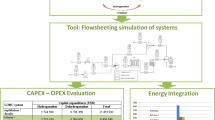Abstract
The demand for hydrogen, a carbon–neutral fuel, is expected to increase in the coming decades. However, the current storage efficiency of gaseous hydrogen is poor. Liquid organic hydrogen carriers (LOHCs), which store hydrogen in liquid form under ambient conditions, show promise for on-site hydrogen refueling stations. Toluene-methylcyclohexane is one of the LOHC, it has advantages cost-effect and environmentally to large-scale hydrogen transportation, but it should be evaluated risk assessment based on the chemicals, because there is inherent harm from the properties like toxicity or flammability. Herein, quantitative risk assessment (QRA) results for worst-case scenarios, individual risk (IR), and societal risk (SR) for a methylcyclohexane-based on-site hydrogen refueling station (MHRS) are compared with those a gaseous hydrogen refueling stations (GHRS). The latter is more likely to have explosion-related accidents, while the former is more likely to have had fire-related accidents. Both show similarly high societal risks. The rupture of the MCH storage tank poses the most significant risk, but installing a dike reduces by 86%, thereby placing it within acceptable limits. Thus, the key risk factors for future on-site hydrogen refueling stations are identified and insights into mitigating them are offered.














Similar content being viewed by others
Abbreviations
- AHRS :
-
Ammonia-based hydrogen refueling station
- ALARP :
-
As low as reasonably practicable
- EIHP-2 :
-
European Integrated Hydrogen Project 2
- ERPG :
-
Emergency response planning guide
- ESD :
-
Emergency shutdown
- ETA :
-
Event tree analysis
- F-N :
-
Frequency of events which causes at least N fatalities
- FCEV :
-
Fuel-cell electronic vehicles
- GHRS :
-
Gaseous hydrogen refueling station
- H2 :
-
Hydrogen
- HMB :
-
Heat and mass balance
- HRS :
-
Hydrogen refueling station
- IR :
-
Individual risk
- LOHC :
-
Liquid organic hydrogen carrier
- MCH :
-
Methylcyclohexane
- MHRS :
-
MCH-based hydrogen refueling station
- PFD :
-
Process flow diagram
- PSA :
-
Pressure swing adsorption
- QRA:
-
Quantitative risk assessment
- SNL:
-
Sandia National Laboratory
- SR:
-
Societal risk
References
Special report- global wawrming of 1.5°C. 2018, IPCC
IRENA, Global Energy Transformation: A roadmap to 2050. 2018
Net Zero by 2050 A Roadmap for the Global Energy Sector. 2021, IEA
G. Gowrisankaran, S.S. Reynolds, M. Samano, Intermittency and the value of renewable energy. J. Polit. Econ. 124(4), 1187–1234 (2016)
D. Reiche, M. Bechberger, Policy differences in the promotion of renewable energies in the EU member states. Energy Policy 32(7), 843–849 (2004)
T. He et al., Hydrogen carriers. Nat. Rev. Mater. 1(12), 16059 (2016)
M. Aziz, Liquid hydrogen: a review on liquefaction, storage, transportation, and safety. Energies 14(18), 5917 (2021)
Z.J. Wan et al., Ammonia as an effective hydrogen carrier and a clean fuel for solid oxide fuel cells. Energy Convers. Manage. 228, 113729 (2021)
P.M. Modisha et al., The prospect of hydrogen storage using liquid organic hydrogen carriers. Energy Fuels 33(4), 2778–2796 (2019)
M. Niermann et al., Liquid organic hydrogen carrier (LOHC) - assessment based on chemical and economic properties. Int. J. Hydrogen Energy 44(13), 6631–6654 (2019)
J.-S. Lee et al., Large-scale overseas transportation of hydrogen: comparative techno-economic and environmental investigation. Renew. Sustain. Energy Rev. 165, 112556 (2022)
Institute, W.R. Climate Watch Historical GHG Emissions. 2022; Available from: https://www.climatewatchdata.org/ghg-emissions
(LBST), L.-B.-S., Another record number of newly opened hydrogen refuelling stations in 2021, In: 14th Annual assessment of H2stations.org by LBST, H2Stations.org, Editor. 2022
(IEA), I.E.A., The Future of Hydrogen. 2019
Hydrogenius, Hydrogen stored as an oil. 2020
L. Lin et al., Techno-economic analysis and comprehensive optimization of an on-site hydrogen refuelling station system using ammonia: hybrid hydrogen purification with both high H 2 purity and high recovery. Sustain. Energy Fuels 4(6), 3006–3017 (2020)
H.R. Gye et al., Quantitative risk assessment of an urban hydrogen refueling station. Int. J. Hydrogen Energy 44(2), 1288–1298 (2019)
Z.Y. Li, X.M. Pan, J.X. Ma, Quantitative risk assessment on 2010 Expo hydrogen station. Int. J. Hydrogen Energy 36(6), 4079–4086 (2011)
K. Tsunemi et al., Quantitative risk assessment of the interior of a hydrogen refueling station considering safety barrier systems. Int. J. Hydrogen Energy 44(41), 23522–23531 (2019)
T. Suzuki et al., Quantitative risk assessment using a Japanese hydrogen refueling station model. Int. J. Hydrogen Energy 46(11), 8329–8343 (2021)
B.H. Yoo et al., Comparative risk assessment of liquefied and gaseous hydrogen refueling stations. Int. J. Hydrogen Energy 46(71), 35511–35524 (2021)
S.H. Bae et al., Design-based risk assessment on an ammonia-derived urban hydrogen refueling station. Int. J. Energy Res. 46(9), 12660–12673 (2022)
J. Nakayama et al., Preliminary hazard identification for qualitative risk assessment on a hybrid gasoline-hydrogen fueling station with an on-site hydrogen production system using organic chemical hydride. Int. J. Hydrogen Energy 41(18), 7518–7525 (2016)
J. Nakayama et al., Simulation-based safety investigation of a hydrogen fueling station with an on-site hydrogen production system involving methylcyclohexane. Int. J. Hydrogen Energy 42(15), 10636–10644 (2017)
J. Nakayama et al., Thermal hazard analysis of a dehydrogenation system involving methylcyclohexane and toluene. J. Therm. Anal. Calorim. 133(1), 805–812 (2018)
J. Nakayama et al., Security risk analysis of a hydrogen fueling station with an on-site hydrogen production system involving methylcyclohexane. Int. J. Hydrogen Energy 44(17), 9110–9119 (2019)
K. Tsunemi et al., Screening-level risk assessment of a hydrogen refueling station that uses organic hydride. Sustainability 10(12), 4477 (2018)
K. Reddi, A. Elgowainy, E. Sutherland, Hydrogen refueling station compression and storage optimization with tube-trailer deliveries. Int. J. Hydrogen Energy 39(33), 19169–19181 (2014)
S. Sircar, T.C. Golden, Purification of hydrogen by pressure swing adsorption. Sep. Sci. Technol. 35(5), 667–687 (2000)
J.K. Ali, D.W.T. Rippin, Comparing mono- and bimetallic noble-metal catalysts in a catalytic membrane reactor for methylcyclohexane dehydrogenation. Ind. Eng. Chem. Res. 34, 722 (1995)
J.K. Ali, D.W.T. Rippin, A. Baiker, Improving methylcyclohexane dehydrogenation with ex-situ hydrogen separation in a reactor-interstaged membrane system. Ind. Eng. Chem. Res. 34, 2940 (1995)
H.H. Funke et al., Separations of cyclic, branched, and linear hydrocarbon mixtures through silicalite membranes. Ind. Eng. Chem. Res. 36, 137 (1997)
K. Oda et al., Dehydrogenation of methylcyclohexane to produce high-purity hydrogen using membrane reactors with amorphous silica membranes. Ind. Eng. Chem. Res. 49, 11287 (2010)
G. Li et al., Methylcyclohexane dehydrogenation in catalytic membrane reactors for efficient hydrogen production. Ind. Eng. Chem. Res. 52(37), 13325–13332 (2013)
E.E. Wolf, E.E. Petersen, Kinetics of deactivation of a reforming catalyst during methylcyclohexane dehydrogenation in a diffusion reactor. J. Catal. 46(2), 190–203 (1977)
Y. Okada et al., Development of dehydrogenation catalyst for hydrogen generation in organic chemical hydride method. Int. J. Hydrogen Energy 31(10), 1348–1356 (2006)
M.S. Akram et al., An exclusive kinetic model for the methylcyclohexane dehydrogenation over alumina-supported Pt catalysts. Int. J. Chem. Kinet. 52(7), 415–449 (2020)
Performance of 10,000 hours of operation in Chiyoda’s demo plant. 2020 [cited 2020 June 8]; Available from: https://www.chiyodacorp.com/en/service/spera-hydrogen/demo-plant/
J.W. Ren et al., Review on processing of metal-organic framework (MOF) materials towards system integration for hydrogen storage. Int. J. Energy Res. 39(5), 607–620 (2015)
I. Dincer, Environmental and sustainability aspects of hydrogen and fuel cell systems. Int. J. Energy Res. 31(1), 29–55 (2007)
M. Niermann et al., Liquid organic hydrogen carriers (LOHCs) - techno-economic analysis of LOHCs in a defined process chain. Energy Environ. Sci. 12(1), 290–307 (2019)
Z.Y. Li, X.M. Pan, J.X. Ma, Quantitative risk assessment on a gaseous hydrogen refueling station in Shanghai. Int. J. Hydrogen Energy 35(13), 6822–6829 (2010)
TNO Purple Book, Guideline for Quantitative Risk Assessment. 1999, Committee for the Prevention of Disasters: The Netherlands
Askarian, A., et al., Hazard Identification and Risk Assessment in Two Gas Refinery Units. Health Scope, 2018. 7(1).
R.L. Dehart, Canadian-center-for-occupational-health-and-safety Ccinfodisc. Jama-J Am. Med. Assoc. 265(18), 2415–2416 (1991)
Jeffrey LaChance, W.H., Bobby Middleton, Larry Fluer, Analyses to Support Development of Risk-Informed Separation Distances for Hydrogen Codes and Standards. 2009, Sandia National Laboratories.
TNO Green Book, Methods for the determination of possible damage to people and objects resulting from release of hazardous materials. 1992, Committee for the Prevention of Disasters: The Netherlands
NA, E., Vulnerability model a simulation system for assessing damage resulting from marine spills. 1975
Zhang, M., et al., Accident consequence simulation analysis of pool fire in fire dike. In: 2014 International Symposium on Safety Science and Technology, 2015. 84: 565–577.
Association, N.F.P., NFPA 704 Standard System for the Identification of the Hazards of Materials for Emergency Response. 2020: National Fire Protection Association.
National Fire Codes, 7. 1985, National Fire Protection Association: Batterymarch Park, Quincy, MA.
Crowl, D.A. and J.F. Louvar, Chemical Process Safety: Fundamentals with Applications. 2011: Pearson education international.
Norske Hydro ASA and Det Norske Veritas AS for WP5.2 & Risk acceptance criteria for hydrogen refueling stations. 2003, European Integrated Hydrogen Project 2 [EIHP-2]
Y.D. Jo, B.J. Ahn, A method of quantitative risk assessment for transmission pipeline carrying natural gas. J. Hazard. Mater. 123(1–3), 1–12 (2005)
C.H. Shin, Improvement in the risk reduction of dikes of storage tanks handling hazardous chemicals. Crisisonomy 12, 83–89 (2016)
Acknowledgements
This work was supported by the Human Resources Development (No.20214000000280) of the Korea Institute of Energy Technology Evaluation and Planning (KETEP) grant funded by the Korea government Ministry of Trade, Industry and Energy, and the Chung-Ang University Graduate Research Scholarship in 2022. This research was also supported by the H2KOREA funded by the Ministry of Education (2022Hydrogen fuel cell-003, Innovative Human Resources Development Project for Hydrogen Fuel Cells).
Author information
Authors and Affiliations
Corresponding author
Additional information
Publisher's Note
Springer Nature remains neutral with regard to jurisdictional claims in published maps and institutional affiliations.
Rights and permissions
Springer Nature or its licensor (e.g. a society or other partner) holds exclusive rights to this article under a publishing agreement with the author(s) or other rightsholder(s); author self-archiving of the accepted manuscript version of this article is solely governed by the terms of such publishing agreement and applicable law.
About this article
Cite this article
Chae, HJ., Gye, HR., Lee, JS. et al. Quantitative Risk Assessment of a Liquid Organic Hydrogen Carriers-Based Hydrogen Refueling Station. Korean J. Chem. Eng. 41, 1311–1327 (2024). https://doi.org/10.1007/s11814-024-00124-2
Received:
Revised:
Accepted:
Published:
Issue Date:
DOI: https://doi.org/10.1007/s11814-024-00124-2




